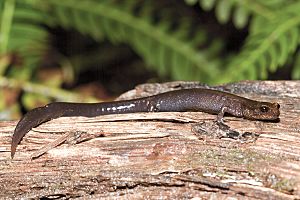Del Norte salamander facts for kids
Quick facts for kids Del Norte salamander |
|
|---|---|
 |
|
| Conservation status | |
| Scientific classification |
The Del Norte salamander (Plethodon elongatus) is a special type of salamander that lives only in a small part of the United States. You can find it in southwestern Oregon and northwestern California. It belongs to a family called Plethodontidae. These salamanders are unique because they don't have lungs! They breathe through their skin and the lining of their mouth.
What Does It Look Like?
The Del Norte salamander is a medium-sized, thin salamander. Grown-up salamanders are usually about 6 to 7.5 centimeters (about 2.4 to 3 inches) long from their snout (nose) to their vent (tail base). Their total length, including their tail, can be from 11 to 15 centimeters (about 4.3 to 5.9 inches).
Their legs are quite short. Their toes are also short and have a slight webbing between them. The top of their body is usually dark brown or black. Some salamanders have a reddish or reddish-brown stripe down their back. This stripe goes from their head all the way to the tip of their tail. Older salamanders might have a stripe that is not as bright.
How Do They Live?
The Del Norte salamander lives entirely on land. It does not need to go into water to breed or at any stage of its life.
Female salamanders lay between three and 11 eggs at a time, with eight eggs being the average. These salamanders do not have a free-swimming larval stage, like tadpoles for frogs. Instead, the young salamanders hatch from their eggs looking like tiny versions of the adults. When they hatch, they are about 18 millimeters (about 0.7 inches) long from snout to vent.
Where Do They Live and How Are They Protected?
These salamanders live in places with moist, rocky ground. They prefer forests with redwood or Douglas fir trees. You can often find them among rocks covered in moss. They also hide under bark or other leaves and debris on the forest floor. They usually avoid areas that are very wet.
The Del Norte salamander is quite common in places where its habitat is suitable. However, it is facing threats. One of the biggest dangers is habitat loss. This happens when their forest homes are destroyed, often because of logging. Protecting these forests helps to keep the Del Norte salamander safe.


